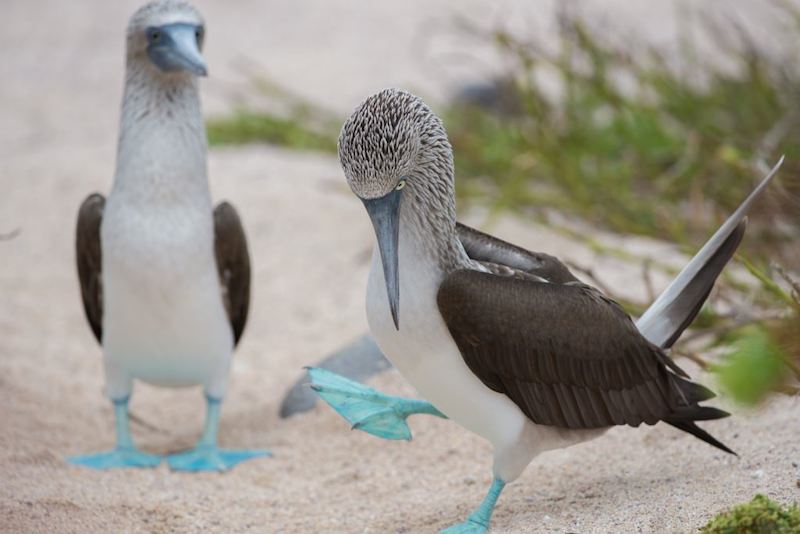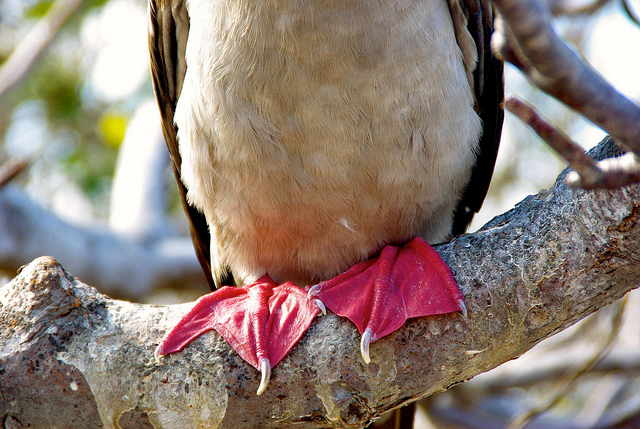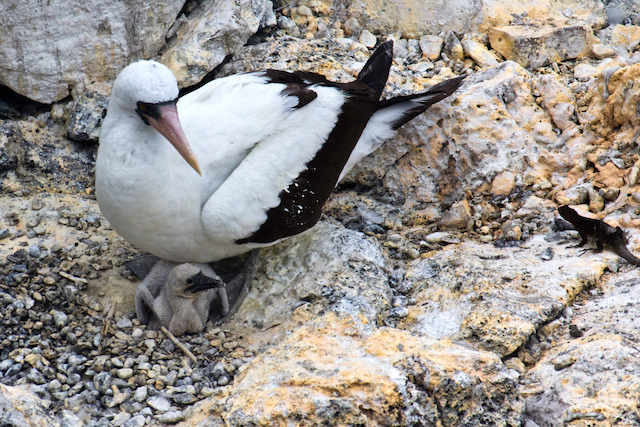Their famous courtship dance, large colorful webbed feet and unforgettable name will help ensure you don’t miss these three distinctive species of boobies when you visit the Galapagos.
The name booby comes from the Spanish word bobo, meaning “clown” or “fool”, because these seabirds appear clumsy on land. Despite seeming clumsy they are extremely graceful in the air and fierce hunters.

ECUADOR, Galapagos, Blue footed Boobies on the rocks at North Seymour Island
Blue Footed Booby
Along a hike in the Galapagos you will look to your right and see a pair of bright blue feet that belong to the famous blue footed booby. Over 70% of the world’s population of blue-footed boobies live in the Galapagos Islands.
Their webbed feet are not only used to attract a mate, but they indicate the level of health and nourishment of the booby. Males and younger birds tend to have lighter feet, while females have darker blue feet.
Suddenly, you see the booby take flight and plunge into the ocean to catch their food. They dive into the water at speeds up to 60 mph, and can go as deep as 80 feet below the surface. In order to dive and catch fish the blue footed boobies have permanently closed nostrils and breathe through the corners of their mouths.
Most famously, everyone who arrives in the Islands wants to see the blue footed booby dance. Have your video cameras ready as they strut around each other lifting and showing off their feet one at a time, pointing their heads and bills to the sky with their wings spread wide.

Red Footed Booby
Your eyes won’t only be drawn to the bright red feet of the red footed booby. Their bills are a beautiful sky-blue color with a pink shade between their eyes and around their chin. They are the smallest of the three boobies, and due to their size they fall prey to the Galapagos Hawk.
When you are looking for red footed boobies nests, don’t look on the ground where both the blue footed and Nazca boobies build their nests, instead these boobies build their nests in the trees. You will also find they only lay one egg at a time, while the other two booby species lay two or three. Once red footed boobies have laid the egg, both parents will sit and incubate it for 44 – 46 days.

Nazca Booby
Unlike the brightly colored feet of their counter parts, the Nazca Booby doesn’t have bright red or blue webbed feet, but they do have a pure white head and neck with a black face, giving it the appearance of a mask.
Don’t be surprised if you see an egg that has been kicked out of its nest. Nazca Boobies are known for practicing “siblicide”. Females lay two eggs several days apart. If both eggs hatch, the older one pushes the younger one out of the nest. Rarely is that baby bird adopted by another bird, this second egg is typically left to die of thirst or cold. This is not dependent on food supply and the parents do not interfere with the practice.
The Nazca Boobies are the largest of the three, and were once thought to be a part of the masked booby species, but now are in their own category. The main way to tell the two apart is the Nazca boobies have an orange/reddish bill color and masked boobies have a yellow bill.




